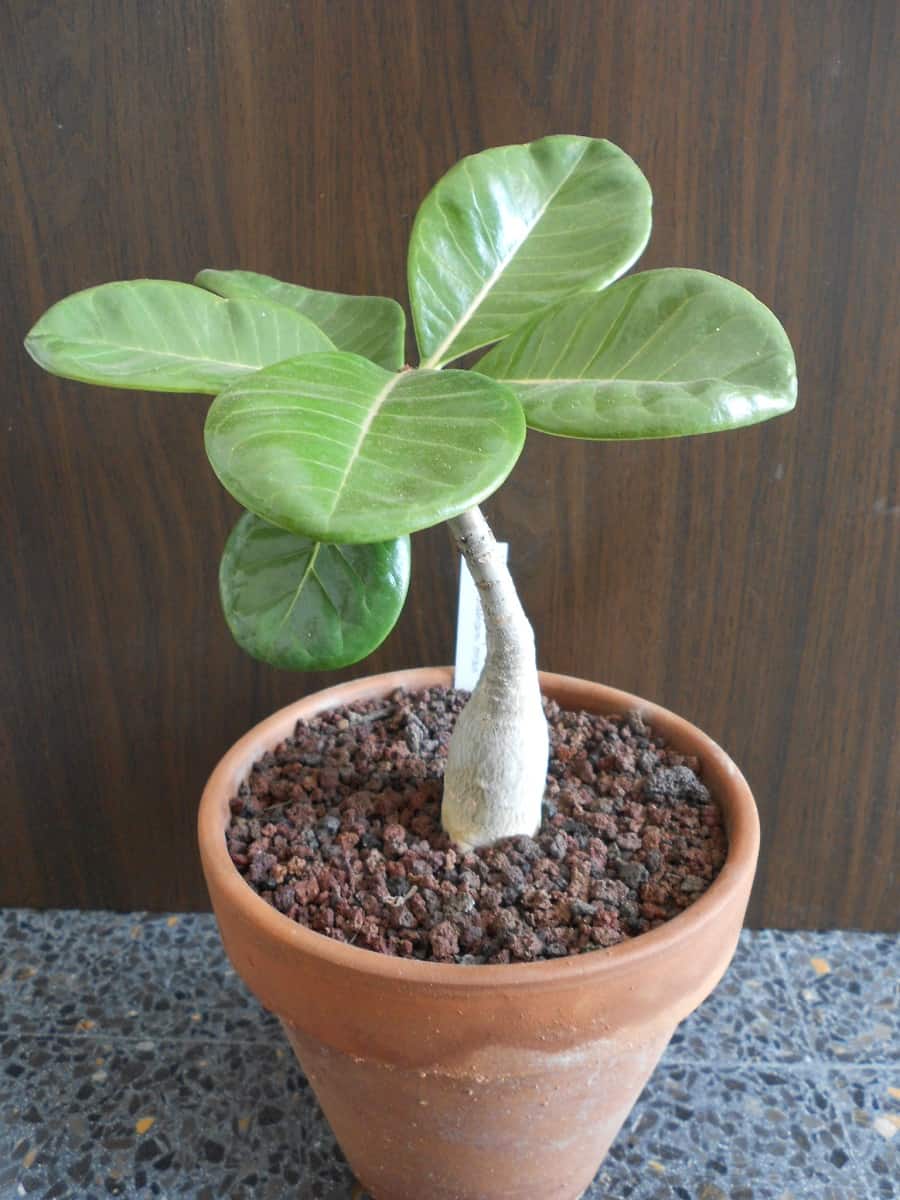Adenium dhofarense is a shrubby succulent that can grow up to 3 m tall but slow-growing.
It also has a shape quite similar to a dwarf baobab.
The leaves are extremely large and shiny.
Adenium dhofarense produces small flowers that usually come out when the plant runs out of leaves.
The Adenium dhofarense forms one of the most beautiful caudex (basal stem) of the genus Adenium.
A characteristic of the branches of Adenium dhofarense is that they have the ability to produce roots where they touch the ground, giving rise to a new plant.
As we mentioned earlier, the flowers of this species are small; they are also pink and are produced in the summer before the leaves begin to emerge.
The Adenium dhofarense is perfect to have in your garden, as it is a very beautiful plant.
During some months of the year, you will have one plant full of green leaves, and the other part will have no leaves but will have beautiful small flowers adorning the branches.
Adenium dhofarense Care
Follow these steps, and you won’t have any issue with the care of your succulent plant.
Illumination
Adenium dhofarense is a species that should be grown in full sun, although it tolerates growing under filtered sunlight or semi-shade.
It is important not to have it in total darkness, since in poorly lit places, the plant will lose all its leaves and even die from lack of sunlight.
Substratum
The Adenium dhofarense must be planted on a substrate with perfect drainage and with the ability to dry quickly.
If you want to keep it in a pot, I recommend a mixture of coarse sand, small stones, and charcoal pieces.
If you want to have the plant directly in the garden, it is best to make a large hole and fill it with one of the substrates mentioned above.
Propagation
Adenium dhofarense can be propagated both by cuttings and by seeds.
Either of the two options you choose will be relatively easy to do; you just have to follow the instructions that I leave you below.
Reproduction by cuttings:
If you want to propagate by cuttings, the first thing you should do is take a cutting from the mother plant’s stem about 10 to 15 cm high.
If you want to help the plant spread, you can soak the cutting in rooting hormone for 15 minutes, but only wet the cut area, never the leaves.
Then you must sow the cutting in a pot with a sandy substrate and with good drainage, bury the cutting about 5 cm.
Water the plant every 3-4 days.
Keep the plant in a bright area but without direct sunlight.
When the new plant reaches its first month, you should place it in full sun and protect it from winter’s low temperatures.
You will notice that your plant is doing well when new leaves start to grow.
Reproduction by seeds:
Once you have the seeds spread (with 5 cm of separation between each seed) on a seedbed filled with a mixture of coarse sand, universal substrate and a small amount of organic compost.
Cover the seeds with a light layer of soil but remember it should be light.
Keep the soil moist by watering the seeds every three days.
It is best to water with a spray bottle and take care that the soil does not puddle to prevent the seeds from rotting.
The best temperature for the seeds to germinate is 28ºC/82°F or more.
That is why the best time to propagate your Adenium dhofarense is in summer, never in winter.
When the seeds begin to germinate, you must stop watering them for a period of 20 days; after this time, you must water them every 15 days.
Once the plant has 6 to 10 leaves, the plant is ready to be transplanted into the pot you want it to grow (it can also be directly in the garden).
Just remember that the pot must have a drainage hole, and wherever you plant your plant, it receives a good amount of daily sun.
Watering
Irrigation is a very important point for the growth of this plant.
The waterings should be moderate; during the summer and spring, you can water once every 15 days and 1 time a month in winter and fall.
Also, be aware of always avoiding waterlogging, as this can cause the plant to rot.
Pests or diseases
The main enemy of this plant is the excess humidity that will cause the rotting of its roots and fungi’ appearance.
That is why it is very important that you take care of the way you water and have a good substrate.
Aphids or mites may also appear that we must control with insecticides.
Fertilization
You can fertilize Adenium dhofarense during spring and summer with a specific fertilizer for cacti and succulents but in low concentrations.
You can fertilize once a month during spring and summer.
Temperature
Optimal temperatures for growth must be above 25⁰C/77°F.
Temperatures below 59°F can cause irreversible damage to the plant, such as root rot.
Transplant
The perfect time to transplant your Adenium dhofarense is when you notice that your plant’s roots begin to come out through the drainage hole of the pot.
If this is the case, transplant your Adenium dhofarense into a pot about 3 to 4 cm larger than the previous one.
If the plant is planted directly in the garden, the transplant is not necessary.
The best time to transplant your Adenium dhofarense is in summer; avoid doing it in winter at all costs; due to low temperatures, the plant can be mistreated.
Pruning
Although pruning your plant is not totally necessary, doing it regularly will help maintain the plant’s health.
It is also good to eliminate (during growth season) the suckers, leaves, and flowers that are withered, dry, or that were attacked by some plague.
All this will avoid the plant getting sick from plagues and will make your succulent look much prettier.
